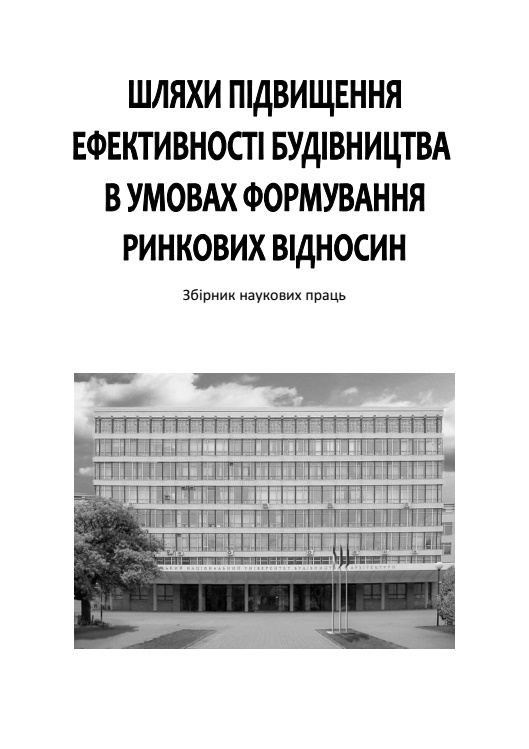Methodical basis of formation of digital space performance of contractual construction works
DOI:
https://doi.org/10.32347/2707-501x.2021.47(1).79-86Keywords:
digital space of construction organizations, formalized digital space of contract works, tools of graph-analytical visualization of work performance by a contractor, geometric econometrics, BIM-modeling, construction development project, Industry-4.0Abstract
The article searches for an appropriate methodology for the formation of methodological and formal analytical basis for the modernization of models of construction organization based on BIM models.
The leading area of application of BIM-technologies in construction is the transformation of disparate graphic and tabular elements from the design and estimate documentation into a single system of info-graphic graphic modules, which are integrated by a single information retrieval system. However, in the realities of the domestic construction market and construction administration systems, BIM technologies remain an aid to the visual-graphic and analytical presentation of the content of a construction development project as an object of construction and investment. However, the strategic trend of this market is the formation of construction development as a single environment of the construction project and as a format of construction administration. Given such strategic dominants, there is a need to redirect and readjust the functional content and graph-analytical design of VIM-technologies to the peculiarities of preparation and organization of the construction development project cycle (BDP) – from promoting the initial investment product idea to the end of the development contract. BIM-technologies should no longer be considered solely as an additional tool for visualizing the progress of the project cycle.
It is substantiated that the digital space of the construction industry (construction projects, construction organizations-participants) in the development of information and communication technologies acquires the characteristics of an alternative construction business, which should function in a certain transformed environment of construction development projects. Technologies directly related to design and construction (BIM, augmented reality, laser scanning, etc.) increase the efficiency of investment and construction projects, while digital data analysis systems contribute to a better understanding of construction market trends.
References
Бондар О.А. Методологічні основи формування галузевої теорії ефективного управління підприємством: дис. ... д-ра екон. наук: 08.00.04 / Бондар Олена Анатоліївна; Київ. нац. ун-т буд-ва і архіт. – К., 2013. – 546 с.
Бондар О.А., Поколенко В.О., Петренко А.С. Сучасні трансформації інноваційного розвитку будівельного підприємства. Scientific letter of Academsc Sopciety of Michail Baludyansky, Volume 9, №6a, 2020, р. 15-23
Пилипчук О.Д., Поколенко В.О. Тенденція розвитку цифрового простору будівельної галузі України. Budownictwo o zoptymalizowanym Potencjale energetycznym. Construction of optimized Energy potential. Wydział Budownictwa Politechniki Częstochowskiej. 2016. № 1 (11). Р. 102-110.
Лучко О.Д. Доцільність формування цифрового простору в будівництві // Прикладна геометрія та інженерна графіка: зб. наук. праць. – Вип. 79. – К.: КНУБА, 2008. – С. 92-100.
Piłat M. How organizational culture influences building a learning organization // Forum Scientiae Oeconomia. – 2016. – № 1. – p. 83-92.
Primavera Project Planner 3.1 веб-сайт. URL: http://primavera-project-planner.software.informer.com/3. l/.(дaтa звернення: 26.12.2020).
Schauppa E., Abelea E., Metternicha J. Potentials of digitalization in tool management. In: The 50th CIRP Conference on Manufacturing Systems. Procedia CIRP 63 (2017) 144-149.
Spider project professional. веб-сайт. URL: http://www.spiderproject.ru /enter.php?ver=prof&lang=rus. (дата звернення: 24.12.2020).
Strack R. et al. How to Gain and Develop Digital Talent and Skills. URL: https://www.bcg.com/de-de/publications/2017/peopleorganization-technology-how-gain-develop-digital-talent-skills.aspx. (дата звернення: 21.12.2020).
The Global Competitiveness Report 2014-2015. URL: http://www.weforum.org. (дата звернення: 22.12.2020).
JANSEN | ведущая компания в сфере управленческого консалтинга https://jansen.com.ua/?gclid=CjwKCAjwvMqDBhB8EiwA2iSmPLu1-ZanIOKQ6vN3fKMgiHFXHQ96cieRzfEasH-zz08G-ulNjMaBWBoCaXMQAvD_BwE (дата звернення: 25.12.2020).
What do you need to become a true BIM professional? https://biblus.accasoftware.com/en/bim-manager-bim-specialist-and-bim-coordinator-roles-and-responsibilities/?utm_source=13839&utm_medium=professioni-bim-btn&utm_campaign=mail-acca-en (дата звернення: 25.12.2020).
Wagner T., Herrmann S., Thiede S. Industry 4.0 Impacts on Lean Production Systems. In: 49th CIRP Conference on Manufacturing Systems (CIRP-CMS 2016). Procedia CIRP 63 (2017) 125-131.
Whitley R. The Institutional Structuring of Organizational Capabilities: the Role of Authority Sharing and Organizational Careers // Organization Studies. – 2003. – № 5. – Р. 667-695.
Directives and policies. URL: https://www.iso.org/directives-and-policies.html (дата звернення: 10.12.2020).
Foreword - supplementary information. URL: https://www.iso.org/foreword-supplementary-information.html (дата звернення: 10.12.2020).
Downloads
Published
How to Cite
Issue
Section
License

This work is licensed under a Creative Commons Attribution 4.0 International License.
Authors who publish with this journal agree to the following terms:
- Authors retain copyright and grant the journal right of first publication with the work simultaneously licensed under a Creative Commons Attribution License that allows others to share the work with an acknowledgement of the work's authorship and initial publication in this journal.
- Authors are able to enter into separate, additional contractual arrangements for the non-exclusive distribution of the journal's published version of the work (e.g., post it to an institutional repository or publish it in a book), with an acknowledgement of its initial publication in this journal.
- Authors are permitted and encouraged to post their work online (e.g., in institutional repositories or on their website) prior to and during the submission process, as it can lead to productive exchanges, as well as earlier and greater citation of published work (See The Effect of Open Access).

